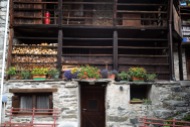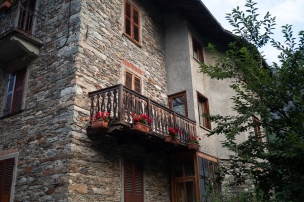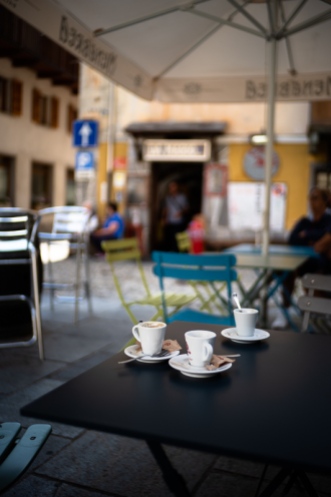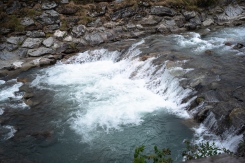Qualche giorno nelle Alpi please scroll down for english text, thanks
Forse il caldo, la siccità, il pensiero di essere in un paese che con le elezioni vicine si sta spostando sempre più a destra io sentivo proprio una vocina dentro di me che diceva, suggeriva, imponeva quasi “fatti una vacanza, SUBITO”. E allora per rinfrescare sia lo spirito sia la mente mia moglie ed io siamo partiti.
Perhaps the heat, the drought, the thought of being in a country that with elections coming up is shifting more and more to the right I just felt a little voice inside me saying, suggesting, imposing almost “take a vacation, NOW.” So to refresh both the spirit and the mind my wife and I left.
Agli inizi dello scorso agosto abbiamo trascorso un paio di giorni in Val Sesia, nelle Alpi. Cercavamo di allontanarci dal caldo opprimente della pianura e ci siamo riusciti, anche troppo visto che dopo tre mesi di forte siccità abbiamo trovato gli unici due giorni di pioggia!
Early last August we spent a couple of days in Val Sesia in the Alps. We were trying to get away from the oppressive heat of the plains and succeeded, even too much so since after three months of severe drought we found the only two days of rain!
Fedeli al motto in vacanza non esiste buon o cattivo tempo ma solo buon o cattivo  equipaggiamento non ci siamo lasciati scoraggiare e abbiamo goduto delle buone temperature. Simo ha potuto usare l’impermeabile acquistato in Norvegia in occasione del nostro roadtrip di qualche anno fa.
equipaggiamento non ci siamo lasciati scoraggiare e abbiamo goduto delle buone temperature. Simo ha potuto usare l’impermeabile acquistato in Norvegia in occasione del nostro roadtrip di qualche anno fa.
True to the motto on vacation there is no such thing as good or bad weather but only good or bad equipment we did not let the farting discourage us and enjoyed the good temperatures. Simo was able to use the raincoat purchased in Norway on our roadtrip a few years ago.
La valle che non è (ancora ?) molto turisticizzata è stata nel XIII secolo meta della migrazione di una poplazione proveniente dall’altro lato delle Alpi, i Walser che vi si sono insediati dedicandosi ad agricoltura e pastorizia.
The valley, which is ( yet ?) not very touristy, was in the 13th century the destination of the migration of a population from the other side of the Alps, the Walser who settled there engaging in agriculture and farming.
Abili nel lavorare la pietra ed il legno i Walser costruirono le loro case (fortunatamente molte oggi sono perfettamente restaurate) con questi materiali. La parte inferiore delle case Walser, era in pietra dove si trovavano la stalla e la cucina, che erano l’unica parte leggermente calda della casa. La parte superiore era realizzata in legno di larice perché questo legno resiste molto bene alla compressione: infatti doveva resistere al tetto estremamente pesante che era in pietra.
Skilled in working with stone and wood, the Walser built their houses (fortunately many today are perfectly restored) from these materials. Made of stone is the lower part of Walser houses where the stable and kitchen used to be, which was the only slightly warm part of the house. The upper part was made of larch wood because this wood withstands compression very well: in fact it had to withstand the extremely heavy roof which was made of stone.
Al giorno d’oggi molti abitanti della valle vivono di agricoltura, turismo e attività legate al tempo libero, come ciclismo, escursionismo e rafting. Molti vivono ancora nei vecchi villaggi Walser opportunamente restaurati.
Nowdays mamny inhabitants of the valley work in the tourism and leisure, with different open air activities like rafting, cycling and hiking. A few still lives in the old villages appropriately restored.
Ho già parlato dell’abilità di lavorare la pietra che rimane una delle attività della valle. Manufatti in pietra si vedono ovunque. Durante l’inverno, quando non era possibile lavorare nei campi e con il bestiame gli uomini si spostavano nella vicina Francia dove grazie all’abilità di lavorare la pietra preserpparte alla costruzione delle grandi cattedrali. In questo modo appresero la tecnica degli affreschi e dei dipinti che tornati ai loro paesi applicarono alle loro chiese. Anche nei più piccoli paesi della valle le chiese sono riccamente decorate, come questa di Riva Valdobbia sulla cui facciata è rappresentato il Giudizio Universale.
I have already talked about the skill of stone working, which remains one of the valley’s activities. Stone handmade artifacts can be seen everywhere. During the winter, when it was not possible to work in the fields and with animals the men moved to the near France where, thanks to their skill in working with stone, they took part in the construction of the great cathedrals. In this way they learned the technique of frescoes and paintings, which back in their countries they applied to their churches. Even in the smaller towns of the valley, churches are richly decorated, such as this one in Riva Valdobbia on whose facade is depicted the Last Judgment.
I villaggi nella valle sono interessanti con la vita sociale che si svolge nelle piccole piazze ma sono la natura e il fiume gli aspetti che mi hanno interessato maggiormente.
The villages in the valley are interesting with the social life taking place in the small squares but it is the nature and the river that interested me the most.
Dobbiamo soltanto sperare che l’esigenza di incrementare il turismo per creare più posti di lavoro venga coniugata con l’esigenza di mantenere intatta la semplicità e la bellezza di questa valle e dei suoi piccoli paesi.
We just have to hope that the need to increase tourism to create more jobs will be combined with the need to keep intact the simplicity and beauty of this valley and its small villages.
 Suggerisco di cliccare sulle foto per vederne una versione ingrandita e ricordo che ogni commento, suggerimento o pensiero è gradito nei commenti, molto più di un semplice like. Grazie 🙂
Suggerisco di cliccare sulle foto per vederne una versione ingrandita e ricordo che ogni commento, suggerimento o pensiero è gradito nei commenti, molto più di un semplice like. Grazie 🙂
I suggest clicking the photos to see an enlarged version and remind that any comment, suggestion or thought is welcome in the comments, much more than just a like. Thanks 🙂



















Your wish to balance tourism with simplicity is one that I hope comes true. I just finished a book about Bhutan, which, you probably know, works very hard to maintain a sane balance. Your photos are very nice and the information about the wood used for houses and the frescoes is fascinating! Thank you very much. (And I’m glad you got away from the heat!)
Interesting story about the construction of the houses. It’s always interesting to admire good craftsmanship.
I am often surprised about the amount of knowledge they had in those times. Like as I said to use larch wood and not other available wood because this could stand the heavy weight of the roof made with stones
Yes, Robert there was a lot of knowledge passed down within different trades. Same with herbal and home-type medicines that were used quite effectively.
Robert, your model is perfect as usual. Your images overall are great! The new lens is sublime!
This is an enjoyable post and makes one long for a visit in the Alps!
Thank you!:)
Thanks Dave, and consider the “new” lens is more or less 20 years old!
This valley is very new e because they kept tourism sustainable without too many artificial structures
What a wonderful place to escape to, with such heat in many parts of Italy (and Europe).
I was recently involved in a project to record some Italian migrant stories, of Italians who came to the area in Australia where I live. This resulted in a gratifying book which will be treasured by generations to come.
Several of the families had their origins in Valli de Passubio which might be in the area you were visiting.
Thanks Yvonne for your words. You are right, a beautiful place to relax and recharge the batteries. Valli del Pasubio is about 300 km from this place, but I know it because I lived not far from it for almopst 20 years.
I’m sure the book will be very interesting and a satisfaction for you.
I had to smile at your ability to find those two days of rain. It reminded me of a trip I made a few years ago to the Arkansas mountains, to see the fall foliage. Every day the fog was so thick I barely could see the road, let alone the mountains.
I knew nothing of the Walser. The houses are so appealing, especially since I’m quite fond of stonework. My favorite photo is of the houses on the mountainside; the embedded stone in the foreground helps to tell the story of their construction.
In the last photo, are those prayer flags? They remind me of photos I’ve seen of such from Asian countries.
It seem me ti find rainy days is among my specialties! Not the forst time and I remember even when I was young it happened when on a short trip or holiday with my Mom!
I’m fascinated by the Walser’s ability to work both stone and wood with excellent results, two material so different!
Yes, there are prayer flags in the last photo, perhaps some of the inhabitans are following an asian freligion. Or it is a sign of support for the Tibetan people…